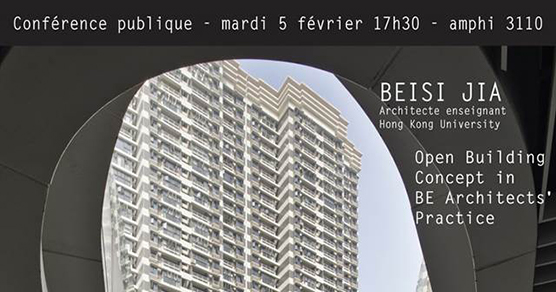Conférence de Beisi Jia | « Open Building Concept in BE Architects’ Practice »
5 février 2019
Annonce :
“INVITATION – Conférence publique
Mardi 5 février 17h30, amphithéâtre 3110
Beisi Jia, architecte et professeur à la Hong Kong University
Open Building Concept in BE Architects’ Practice
Beisi Jia est également associé et directeur du bureau de Hong Kong de l’agence internationale Baumschlager Eberle Architects. Lors de sa conférence, il présentera trois projets récents réalisés par l’agence Baumschlager Eberle Architects (BEA) afin d’illustrer le concept du « Open Building ».
Abstract: Despite the transformation of urban density into a hot topic in architectural research, and the concept of sustainable city having been long implemented as part of the city policy, in-depth research on the theoretical understanding on the new form of urban complexity or its impact on the spatial quality based on the study of newly built cases is little. This speech introduces a theory of Open Building and Infrastructuralism in Architectural practice. The observations are based on the classification of three social-spatial levels with focus on the performance of public space, adaptability of the buildings and interactive with users. This speech introduce three recent completed projects, carried out by our office, Baumschlager Eberle Architects (BEA) Hong Kong. We will discuss the quality and capacity social interactive spaces in three different scales, public spaces, building and interior refurbishment in relation to the importance of the atmosphere as design quality and interactive procedures in the design process. We would drew attention on the typological difference among the capacity of built environment in three levels:
- In the urban public space, the high capacity address the importance of safety and comforts with identity of community.
- On the building level, a neutrality of plan is important to accommodate a diversity of occupancy groups.
- On the infill level, interaction and operable instrument are the keys to fulfil and stimulate both multiple programs and temporary identities.”
Pour consulter l’affiche de la conférence…
Pour visiter le site internet de l’École d’architecture de l’Université de Montréal…
Publié le 25 janvier 2019
